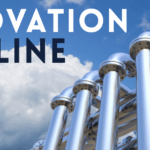What is Innovation Software?
Innovation Software Helps Businesses Cultivate and Implement Innovation — Faster.
Innovation software was made possible by the rise in popularity of both cloud computing and social sharing platforms. The main goal of this software is to help enterprise level businesses generate and evaluate ideas so that innovation can be cultivated and implemented. The software serves as an important tool that facilitates collaboration while also providing an organized selection process that pushes the best ideas forward without getting bogged down by big data.
Different innovation software programs provide one central location for people from around the world to participate in the submission and evaluation process. Various functionalities are also meant to improve communication, collaboration and brainstorming. Other tools help with analyzing and visualizing ideas in order to streamline project management and create a clear workflow as ideas move through the development pipeline.
Traditionally, corporations have relied on internal employees to develop new ideas, but innovation software works to gather input from both internal and external sources. This approach helps to recruit talent from around the world and drive innovation while also protecting intellectual property and creating a centralized repository for ideas. In fact, some companies have used contests and the gamification of innovation to encourage participation.
The Power of Analytics and Reporting
One of the unsung heroes of innovation software is its robust analytics and reporting capabilities. Instead of relying on gut feelings or endless meetings (we’ve all been there), teams gain access to clear, data-driven insights that shine a spotlight on what’s working and what might need a little more tinkering.
With detailed dashboards, trend reports, and performance metrics at your fingertips, it’s suddenly much easier to spot promising ideas before they slip through the cracks. You can evaluate which submissions are gaining traction, where your resources will have the most impact, and proactively address any bottlenecks in your innovation pipeline.
Many platforms now bring some artificial intelligence to the party—tools that can track patterns, flag standout concepts, and even recommend next steps based on previous successes (think of them as the friendly data nerds you never knew you needed). This means teams can move more confidently, prioritizing high-impact projects and dodging potential pitfalls along the way.
By translating a mountain of raw data into actionable insights, analytics and reporting features ensure that your innovation efforts aren’t just busy—they’re smart, strategic, and future-focused.
How is Innovation Software Used?
By providing one location to capture, evaluate and develop ideas, companies are able to create an organized path to innovation. In the past, ideas would be directed to different departments through a wide variety of channels and there was a good chance that a promising idea would fall through the cracks. Innovation software ensures that every idea is properly evaluated and that employees, at every level, are being fully utilized and recognized for their contributions.
Idea Capture
One of the primary functions of innovation software is to provide secure idea capture capabilities for a network of employees or a protected group. The software can designate exactly who is a part of which group and assign certain privileges to members. Forming groups just takes a few clicks and all information, including shared documents and original ideas, will be protected.
For companies who want to expand their search, innovation software can be used for external idea capture. This allows companies to recruit and collaborate with top talent from around the world. A curated network of researchers, engineers, academics, tradesmen and even consumers will have the opportunity to submit ideas and help drive innovation.
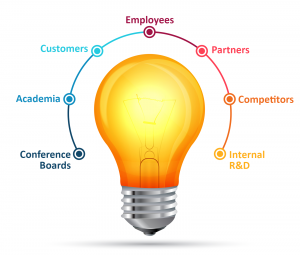 Companies also have the option to choose between unstructured and structured idea capture methods. An unstructured approach allows for the open submission of ideas by any contributor without limitations. Participants are protected by blanket terms and conditions that are designed to secure intellectual property (IP) and reduce risk. For a more customized approach, structured methods can be used that rely on a form-based process that limits the submission of ideas. This layered approach to submissions is meant to protect both the client and the problem solver.
Companies also have the option to choose between unstructured and structured idea capture methods. An unstructured approach allows for the open submission of ideas by any contributor without limitations. Participants are protected by blanket terms and conditions that are designed to secure intellectual property (IP) and reduce risk. For a more customized approach, structured methods can be used that rely on a form-based process that limits the submission of ideas. This layered approach to submissions is meant to protect both the client and the problem solver.
When innovation software does not allow for the submission of unsolicited ideas, companies can inadvertently restrict the diversity and richness of their innovation pipeline. Without an open channel for unexpected suggestions, some of the most creative or disruptive concepts—often originating from unexpected sources—may never enter the evaluation process.
This limitation can deprive organizations of out-of-the-box ideas that classic challenge-based or structured processes might miss. After all, companies like Google, 3M and Lego have famously benefited from spontaneous employee suggestions that weren’t driven by a formal prompt. Without this avenue, there’s a risk that employees or outside collaborators will feel disengaged, and potentially game-changing ideas may go unheard.
Common Challenges in Managing Idea Capture
While the ability to collect and manage ideas from a broad network is powerful, several common challenges can hinder the success of innovation initiatives:
- Information Silos and Fragmented Efforts: When departments or teams work in isolation, valuable insights often remain trapped within one group, leading to redundant efforts and limiting holistic innovation. An open, accessible idea capture system helps break down these silos and encourages cross-functional collaboration.
- Fair Evaluation and Prioritization: With a high volume of submissions, it’s easy for organizations to become overwhelmed and miss promising concepts. Traditional evaluation processes may be inconsistent or subjective, allowing biases to creep in. Without objective criteria and transparency, some of the best ideas may never get the attention they deserve.
- Resource Alignment: Even when strong ideas surface, organizations can struggle with allocating the right time, budget, or expertise to move projects forward. Misalignment of resources can result in delayed or stalled initiatives—especially in industries where speed is essential.
- Workflow Complexity: Managing the entire journey from idea capture to implementation can be daunting. Without clear workflows and visibility into progress, bottlenecks can form, and promising innovations can lose momentum.
Ensuring that both solicited and unsolicited ideas have a place in the system helps tap into the full collective intelligence of your network and keeps contributors motivated to share, regardless of campaigns or challenges underway.
Ensuring that both solicited and unsolicited ideas have a place in the system helps tap into the full collective intelligence of your network and keeps contributors motivated to share, regardless of campaigns or challenges underway.
Challenge-based idea capture can be either structured or unstructured and used to launch specific challenges to a wide audience of participants. With the help of user-friendly interfaces, an unstructured challenge can be created in a matter of minutes. In addition, companies can create an unlimited number of unstructured challenges so that innovative new ideas are always be incubated.
can be either structured or unstructured and used to launch specific challenges to a wide audience of participants. With the help of user-friendly interfaces, an unstructured challenge can be created in a matter of minutes. In addition, companies can create an unlimited number of unstructured challenges so that innovative new ideas are always be incubated.
Some companies choose to launch branded challenges, but there is always the option to remain unbranded. This allows companies to remain completely confidential while innovating. Innovation software can help companies remain anonymous while still running a specific technology challenge that has the potential to yield innovation solutions.
Ultimately, there are practically no limits on how companies can design and issue challenges. Hybrid idea capture methods allow for any combination of branded, unbranded, external, internal, structured or unstructured idea capture. Companies have the freedom to mix it up and create challenges based on their objectives.
How IdeaScale Facilitates Idea Capture and Development
Much like other leading innovation platforms, IdeaScale opens the door for organizations to tap into the collective creativity of employees, customers, and partners worldwide. By nurturing a collaborative environment, the platform makes it simple for users to contribute ideas, engage in open discussions, and collectively shape promising concepts.
At the core is intuitive idea submission—team members, clients, or external contributors can easily share their thoughts or innovations with a few clicks. Once an idea is submitted, others in the community are empowered to vote, comment, and build upon these submissions. This communal feedback loop quickly surfaces standout ideas and encourages ongoing dialogue, leading to richer, more fully developed solutions.
Key features include:
- Open Participation: Anyone within the designated group can submit ideas, ensuring a diverse range of perspectives.
- Community Voting: Popular ideas are prioritized organically as individuals upvote suggestions they believe in.
- Collaborative Discussion: Commenting tools enable users to refine and iterate on ideas together, strengthening concepts before they ever reach decision-makers.
- Streamlined Workflow: As submissions move through the funnel, facilitated discussions and community curation ensure the innovation process stays focused and efficient.
By championing transparency and teamwork, platforms like IdeaScale help organizations not only gather new ideas, but turn them into actionable innovations ready for implementation.
Tools for Organizing and Streamlining Ideas
To make the most of your idea pipeline, consider utilizing robust digital tools that streamline both the generation and organization of concepts. Leading platforms like ClickUp, Miro, and MindMeister offer a range of features designed to simplify collaborative ideation while keeping everything tidy and actionable.
These tools enable teams to visually map out ideas using mind maps, creating clear connections between thoughts, projects, and potential solutions. With intuitive digital whiteboards, teams can brainstorm together in real time, regardless of location—breaking down silos and sparking creative energy that might otherwise go untapped.
Once ideas start flowing, it’s important not to lose momentum. Many platforms allow you to assign specific statuses, set priorities, and allocate responsible team members to each idea. In other words, a great idea can quickly move from a brainstorm sticky note to an actionable task—ensuring nothing gets left behind on the virtual drawing board.
By using these integrated features, companies can capture, develop, and prioritize ideas with precision, fostering an innovation ecosystem where creative sparks can actually lead to measurable outcomes.
Idea Management
Once ideas have been submitted, innovation software goes to work automatically sorting and rating each submission based on predetermined criteria. Ideas can be sorted according to business category, brand, idea, submitter or any other objectives that are important to the company or that particular project. Once ideas are sorted, they can be automatically scored according to a weighted system. This allows project managers to quickly visit the dashboard and identify the top scoring ideas. By relying on predetermined criteria and an automated scoring system, companies can bypass low scoring submissions and focus time and effort on developing the most promising ideas.
Data-Driven Decision-Making
A key advantage of leveraging innovation management software is its robust support for data-driven decision-making. Through integrated analytics and easy-to-navigate reporting dashboards, organizations can monitor trends, assess submission performance, and track the overall impact of their innovation initiatives in real-time.
This transparency not only helps prioritize resources for the most promising projects, but also offers clear visibility into how ideas align with broader business objectives—helping teams like those at Google or 3M spot early signals and compelling patterns.
Increasingly, artificial intelligence and machine-learning features add another layer of intelligence to these tools. By surfacing hidden patterns in the data and generating actionable recommendations, AI-powered platforms help teams evaluate options with greater confidence, ensuring that every decision is grounded in evidence rather than gut feel. This allows organizations to focus attention—not just on the brightest ideas—but on the proposals with the highest potential for impact, reducing risk and amplifying the chances of meaningful innovation.
The Challenge of Resource Allocation
Resource allocation is a perennial sticking point in the innovation management process. Even after identifying a strong pool of high-potential ideas, companies often grapple with how to distribute their time, budget, and talent in a way that supports rapid and effective development. Without a clear approach to assigning resources, it’s all too easy for promising projects to get lost in the shuffle—stalled by bureaucratic delays or starved of critical expertise.
This challenge becomes even more pronounced in industries where speed is essential. If your organization can’t pivot swiftly and direct the right people and funds to emerging ideas, those opportunities can quickly lose their window of relevance. Missteps in resource allocation can mean that, despite a robust flow of creative concepts, only a fraction ever make it to fruition. This not only diminishes the potential ROI of your innovation efforts, but may also leave teams discouraged when exciting ideas languish due to a lack of follow-through.
Strengths and Weaknesses of Using IdeaScale for Idea Management
When considering platforms for managing the influx of ideas, it’s important to look at both the advantages and possible drawbacks. Many organizations find that the most effective systems encourage robust engagement and make idea evaluation as seamless as possible.
On the strengths side, IdeaScale excels at making the innovation journey collaborative. Its interactive features—such as voting and commenting—naturally foster active participation from a broad pool of contributors. This not only increases engagement but helps promising ideas quickly rise to the surface. A supportive customer success team also stands out, delivering timely guidance and empowering users to fully leverage the platform’s features.
However, there are potential challenges to keep in mind. The system’s options for customization can be somewhat limited, which might pose constraints for organizations with very specific workflows or branding requirements. The built-in analytics and reporting tools, while powerful, may demand extra time and effort to master, potentially creating a learning curve for teams new to such platforms. Integration with other enterprise systems may require additional technical resources to achieve a smooth workflow.
One particularly notable limitation: without a dedicated channel for unsolicited submissions, the platform may inadvertently overlook outside-the-box ideas that don’t neatly fit within defined campaigns or challenges. For organizations aiming to capture every spark of innovation, this points to an area worth evaluating as part of the selection process.
Real-Time Brainstorming and Idea Management with Miro
To further empower collaborative innovation, Miro provides a digital workspace where teams can brainstorm, map out ideas, and manage concepts in real-time—no matter where contributors are located. Its infinite canvas means participants have the freedom to visually lay out even the most complex projects, from mind maps to detailed process flows, without running out of room or losing the big-picture view.
Miro’s suite of ready-made templates makes jumpstarting a brainstorming session or organizing a design sprint refreshingly simple. Whether you’re tackling a remote whiteboarding session with post-its, plotting a customer journey, or organizing user stories for agile planning, these prebuilt workflows help teams get organized—and productive—within minutes.
Seamless collaboration is central to the platform. Multiple users can contribute simultaneously, making it easy for teams to add ideas, vote, comment, and refine concepts together in real time. All changes are instantly visible, keeping momentum high and communication friction-free. This real-time capability ensures that every voice is heard and every idea—whether contributed from across the office or from another continent—gets a fair shot at being developed and evaluated.
By integrating these tools, Miro not only supports free-flowing brainstorming but also brings structure to idea management, making it a powerful complement to any company’s innovation process.
Features for Idea Management
For organizations looking to manage the flood of ideas efficiently, platforms like HYPE Innovation offer a comprehensive suite of tools designed to streamline the process from start to finish. At the foundation, these systems provide a centralized repository, ensuring all submitted ideas—from the logical to the audacious—reside in one accessible location.
But it doesn’t stop at simple idea collection. Contributors can collaborate to discuss, refine, and enhance submissions in real-time, allowing organizations to tap into the wisdom of crowds. This collective approach encourages thoughtful debate and development, whether for an incremental improvement or a disruptive breakthrough.
To keep things organized, these platforms come equipped with robust assessment mechanisms. Ideas are evaluated and ranked through configurable criteria, which helps managers quickly recognize concepts that best align with strategic aims. Visual dashboards bring clarity to the status of each idea, making it easy to monitor progress as ideas evolve from spark to execution.
With automated tracking and clear, rule-based scoring, companies can direct attention where it matters most, ensuring promising ideas aren’t lost in the shuffle and are advanced with purpose and precision.
ClickUp for Idea Management: Benefits and Limitations
While ClickUp is a popular and flexible platform for project and idea tracking, its fit as an idea management solution comes with both strengths and constraints to consider.
Benefits:
- Customization for Teams: ClickUp stands out for its ability to adapt workflows, customize dashboards, and create unique statuses to match the needs of diverse teams. Whether you’re running simple brainstorming sessions or managing elaborate innovation pipelines, you get significant flexibility in setting up the environment.
- Versatile Views and Organization: The variety of views—such as lists, boards, and timelines—makes it easier to visualize and filter ideas according to your preferred method. This adaptability supports a range of team processes.
Drawbacks:
- Learning Curve: The same breadth of features that makes ClickUp powerful can also make it daunting, especially for new users. Getting the most out of its capabilities may require substantial setup and training.
- Performance with Complexity: Users managing especially large volumes of ideas or highly detailed workflows have reported the platform may slow down. This can affect efficiency, particularly when time-sensitive evaluations are needed.
- User Experience Gaps: Some features are more intuitive than others, resulting in occasional friction or a less seamless experience—especially when navigating across advanced functions.
- Innovation-Focused Features: Unlike dedicated innovation management platforms, ClickUp lacks built-in modules for automated idea scoring, long-term tracking of innovations, and gamification to encourage contribution. Integration with certain systems, such as CRM or ERP tools, is more limited, potentially complicating holistic data flows or broader collaboration efforts.
Ultimately, ClickUp’s flexibility is its greatest asset for idea management, but organizations with complex innovation needs or a demand for specialized features may need to look for complementary solutions—or explore platforms designed precisely for innovation workflows.
Pros and Cons of Using Miro for Collaborative Idea Management
When it comes to managing ideas collaboratively, platforms like Miro bring unique advantages, as well as some drawbacks to consider for innovation teams.
Advantages:
- User-Friendly Experience: Miro’s simple, intuitive interface makes it approachable for users at every technical level. New contributors can get started quickly, lowering the barrier to widespread team adoption.
- Seamless Real-Time Collaboration: The platform shines when it comes to virtual teamwork, allowing geographically distributed teams to brainstorm and develop ideas together live, often simulating the feel of an in-person whiteboard session.
Potential Pitfalls:
- Performance Issues with Large Boards: As boards fill up with content, users may experience slowdowns in loading and navigating, which can undermine productivity—particularly during dynamic sessions with many contributors.
- Unstructured Idea Submission: While the open nature of idea capture fuels participation, it can also lead to a flood of unorganized inputs. This makes it difficult to objectively compare submissions or surface the most promising concepts, as structured workflows are limited.
- Quality vs. Quantity Dilemma: The ease of contributing often leads to higher submission volume, but not necessarily higher value. Teams might find themselves sifting through a surplus of undeveloped ideas, sometimes fueling what’s jokingly called “innovation theatre” rather than meaningful progress.
- Analytical Shortcomings: Detailed evaluation tools and customizable scoring criteria are limited. This hampers efforts to rigorously screen, assess, and track ideas according to nuanced business requirements and structured processes.
Ultimately, while solutions like Miro make it incredibly easy for teams to collect and share ideas in a visually engaging way, organizations pursuing structured, in-depth innovation management may find themselves wishing for more robust sorting, scoring, and reporting functionalities.
Braineet: Streamlining Collaborative Idea Management
Braineet stands out for its ability to bring structure and clarity to the idea management process. The platform enables team members to capture, categorize, and track ideas in an organized manner, ensuring that nothing gets lost in the shuffle.
What sets Braineet apart is its emphasis on collaboration and knowledge sharing. Teams can openly share best practices, document experiments, and highlight successful initiatives—often referred to as “quick wins.” This approach not only accelerates innovation across departments and business units but also fosters a sense of shared purpose.
By providing tools that allow seamless communication and transparent workflows, Braineet makes it easier to leverage the collective expertise and creativity within an organization. As a result, companies can build a more consistent and effective pipeline of actionable ideas, turning inspiration into measurable progress.
Wazoku: Benefits and Potential Drawbacks
When considering Wazoku for idea management, there are a few clear advantages that stand out. The platform offers a straightforward user experience, which helps teams from various departments get on board quickly. Additionally, users often report that the support team is responsive and knowledgeable—a valuable asset when troubleshooting or learning how to navigate new features.
That being said, there are a few aspects to keep in mind before committing. Some organizations have found the customizability of Wazoku’s interface to be more limited than expected, making it trickier to tailor workflows or integrate with other enterprise tools seamlessly. It’s also worth noting that new users may face a bit of a learning curve; effective use tends to require training, which can slow down adoption, especially across larger teams.
Some users feel that the overall look and feel of the platform could be more engaging, which might impact participation rates over time. Lastly, the analytics capabilities do not always go as deep as some competitors, which could be a consideration if robust reporting and in-depth insights are central to your idea management strategy.
Wazoku Idea Management Features
Wazoku offers a suite of robust tools designed to streamline every step of the idea management journey. At its core, the platform provides dedicated portals where users can easily submit their ideas for consideration—whether those contributors are employees, external partners, or members of an open innovation community. These portals are intuitive and accessible, helping to remove friction from the submission process.
To further enhance the evaluation stage, Wazoku incorporates customizable scoring models and evaluation metrics. This means ideas can be systematically assessed against the criteria most relevant to your business objectives, ensuring fair and transparent decision-making.
Collaboration is another hallmark of the Wazoku experience. The platform includes interactive discussion forums and comment threads, making it simple for contributors to provide feedback, refine concepts, and collectively build on each other’s suggestions. This collaborative ethos taps into the wisdom of crowds, fueling the kind of creativity that leads to breakthrough ideas.
All together, these features are designed to foster engagement, harness diverse perspectives, and help organizations surface their highest-potential innovations with efficiency and clarity.
Limitations and Challenges to Consider
While Brightidea brings a rich feature set to the table, it’s not without its challenges. Some users have compared the platform’s backend to a “pilot’s cockpit”—offering so many controls and configuration options that it can feel overwhelming, especially for newcomers. This complexity may lead to a steeper learning curve for teams who want to jump in and start capturing ideas right away.
In addition to its intricate navigation, the abundance of features can sometimes result in sluggish performance, slowing down key workflows and making the user experience less responsive than expected.
Another point to watch is the mobile experience. Users have noted that the mobile app lacks the polish and robust functionality needed for efficient idea management on-the-go. Persistent bugs and slow updates can further limit its effectiveness for contributors who aren’t desk-bound.
Finally, while the software includes various customization capabilities, some users find that certain templates and pages still don’t offer quite enough flexibility to match every organization’s unique requirements. This can present a hurdle for teams who want to tailor the platform to their specific processes and branding.
Idea Advancement
The next stage in the innovation process is to begin to advance top-rated ideas through a stage-gate workflow. Each company can use the software to create a customized qualification process that can further filter ideas and establish organized workflows according to department, brand, idea type, etc. Essentially, ideas are appropriately directed to the right place for the next stage of review and development.
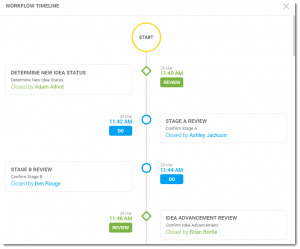 As ideas move along the development pipeline, reviewers can directly communicate with the innovation team and individuals through the centralized dashboard. Supporting documents, including: videos, images, Word documents, PDFs, and other files can be easily shared and viewed by the entire team. In addition, participants can view the collaboration and workflow history in order to understand exactly where a project stands and what steps need to be completed before moving forward.
As ideas move along the development pipeline, reviewers can directly communicate with the innovation team and individuals through the centralized dashboard. Supporting documents, including: videos, images, Word documents, PDFs, and other files can be easily shared and viewed by the entire team. In addition, participants can view the collaboration and workflow history in order to understand exactly where a project stands and what steps need to be completed before moving forward.
Reviewers and collaborators also have the ability to set up automatic alerts so that they can be instantly updated the moment changes are made to the project. By facilitating better communication and automating certain processes, innovation software is able to reduce the amount of time it takes to develop an idea and get products to the market. No matter what stage a project is currently in, innovation software can identify the path to development and move an idea to the next stage.
What to Look for When Evaluating Innovation Management Software
With so many innovation management platforms available, pinpointing the right solution can feel a bit like shopping for a Swiss Army knife—you want something loaded with features, but it also needs to fit snugly in your pocket (and not try to launch a satellite on its own). Here’s a practical breakdown of what really matters when you’re weighing your options:
1. User-Friendly Design
The best innovation software is effortless to use. Aim for platforms that offer intuitive navigation and clean interfaces. If your team needs an instruction manual the size of an encyclopedia, adoption rates will plummet faster than a dropped prototype.
2. Customization That Fits Your Organization
Every business is a little different, with processes, jargon, and brand quirks all its own. Seek out software that empowers you to tweak workflows, tailor templates, and slap your logo wherever it matters—whether you’re running a top-secret tech challenge or an open, branded campaign.
3. Smart Automation and AI Features
Look for platforms that do some of the heavy lifting. Automated routing, notifications, and AI-driven suggestions help sort promising ideas from the noise, keeping your pipeline humming along without endless manual oversight.
4. Built-In Collaboration Tools
Innovation is a team sport—not a solo marathon. Effective platforms come with the digital versions of sticky notes and whiteboards: threaded comments, quick upvotes, file sharing, real-time feedback, and notifications to keep everyone in sync. Bonus points for features like gamification to boost engagement.
5. Seamless Integrations
No one wants another siloed tool. The standout solutions play nicely with the likes of Slack, Trello, Salesforce, Jira, or your go-to project management and CRM systems. This keeps data flowing between departments and curbs that dreaded duplicate entry.
6. Actionable Analytics and Reporting
To know what’s working (and what’s not), you need solid reporting. Advanced analytics surface trends, track participation rates, and help calculate the ROI of your innovation programs—so you can show the board exactly where the magic is happening.
7. Team Spaces & Permission Management
Not every idea is ready for center stage. Good software provides secure project spaces and finely tuned permission controls, ensuring the right people see the right initiatives. That way, IP stays confidential and sensitive ideas are shielded until they’re ready to shine.
8. One Source of Truth
Large organizations sometimes resemble a maze of disconnected apps and databases. Look for unified platforms that act as a central hub—your team should know exactly where to find and manage every idea, campaign, and collaboration thread.
9. Security and Compliance
Sensitive ideas can be the crown jewels of your business, so robust security matters. Confirm that your chosen platform is up to snuff with industry compliance standards, data encryption, and regular audits—a must if you’re in fields like finance or healthcare.
By focusing on these essentials, you can zero in on a solution that blends seamlessly into your current environment, supports your strategic goals, and keeps your brightest minds energized.
Integration Options
A robust innovation management platform doesn’t operate in isolation—it’s designed to play nicely with the rest of your tech stack. Most leading solutions offer out-of-the-box integrations with core business systems to streamline the innovation process and keep all your information where you need it.
Common integration options include:
- Project Management Tools: Many platforms connect seamlessly with software like Jira, Asana, or Trello, allowing your team to transition promising ideas straight into your established workflows.
- CRM Systems: Integrations with Salesforce, HubSpot, or Microsoft Dynamics help you link customer insights and feedback directly into the ideation funnel, bridging the gap between customer needs and innovative solutions.
- ERP Platforms: Tying into enterprise systems such as SAP or Oracle, these integrations facilitate resource alignment and ensure that innovations align with business capacity and priorities.
- Collaboration Suites: Integration with Microsoft Teams, Slack, or Google Workspace makes collaboration on ideas and projects effortless, keeping communication in one accessible hub.
- Single Sign-On (SSO) and Directory Services: Support for SSO and integration with Active Directory or Okta streamline user access and reinforce security.
These integration capabilities remove barriers between teams and systems, reduce manual data entry, and ensure your innovation initiatives stay aligned—whether you’re capturing ideas, managing resources, or tracking progress across departments.
How Qmarkets Drives Idea Collection, Evaluation, and Implementation
Qmarkets stands out as a robust idea management platform, empowering organizations to make the most of their collective insights. By connecting employees, customers, and partners on a single platform, Qmarkets creates an environment where anyone can easily contribute new ideas to propel the business forward.
What sets Qmarkets apart is its flexible workflows, which can be tailored to mirror an organization’s unique innovation goals. Whether the focus is on incremental improvements or breakthrough initiatives, teams can customize how ideas flow from initial capture through to final implementation.
User engagement is another area where Qmarkets shines. The platform embraces gamification—think token-based voting, idea tournaments, and progress badges—which adds a fun, competitive twist that encourages more people to participate and champion the innovation effort. This not only bolsters participation but helps teams surface the best solutions quickly.
Behind the scenes, ideas are automatically grouped and sorted according to your chosen criteria. Decision-makers can easily compare, rate, and prioritize submissions, ensuring that the highest-potential concepts are fast-tracked through the process. Collaborators can seamlessly communicate, attaching documents and sharing feedback in real time, so everyone stays in sync as ideas move from one milestone to the next.
With these features, Qmarkets helps organizations systematically tap into their networks, evaluate proposals, and shepherd winning ideas from the drawing board to real-world impact—making innovation less of a guessing game and more of a strategic advantage.
Agile Innovation Management Features
To further support agile innovation management, advanced innovation software platforms offer a suite of features designed to energize participation and streamline the entire process. For example, teams can launch focused campaigns tailored to tackle pressing organizational challenges, inviting employees at every level to contribute their insights and collaborate on solutions.
Digital tools simplify idea collection, allowing employees to easily submit, discuss, and refine suggestions in real time. Intelligent management systems, often powered by AI, automatically capture feedback, recognize promising ideas, and foster a culture of recognition and engagement. This not only motivates continued involvement, but also ensures that valuable input doesn’t get lost in the shuffle.
With these technologies, organizations can quickly crowdsource solutions, refine concepts through iterative feedback loops, and accelerate the pace at which ideas mature from initial submission to actionable projects. By leveraging these features, companies can remain nimble and responsive in today’s dynamic business landscape.
Who Uses Innovation Software?
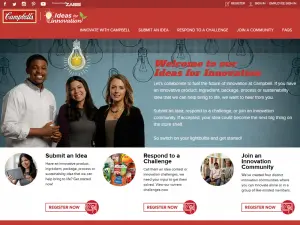
Innovation software was originally designed with enterprise businesses in mind, but there are really no limitations on who can use and benefit from this versatile tool. As you might imagine, more competitive, technology-driven fields, such as finance, healthcare and software development have the most to gain from fostering an environment of innovation. These industries face the most significant increase in global competition, which requires a proactive approach to innovation to stay relevant. Today’s businesses don’t have the luxury of simply adapting to evolving markets. They must anticipate and lead trends or risk being left behind. Innovation software serves as a vital tool that is able to capture and develop ideas more easily than ever.
Why Do Businesses Use Innovation Software?
Create a culture of innovation. Companies need to go beyond simply talking about the importance of innovation and actually empower employees with tools they need to actively contribute to the company and have their ideas heard. The corporate environment often relies heavily on a hierarchy that discourages lower level employees from sharing ideas or questioning the status quo. Innovation software removes these perceived boundaries and effectively creates a culture of innovation where ideas are welcomed and given appropriate attention without getting overwhelmed with information.
 Increase employee engagement. The ability to simply log into a centralized dashboard and quickly submit an idea had proven time and again to increase employee engagement. When innovation challenges are formatted as a contest or game, engagement increases even more. This means that employees are more invested in the success of the company and feel like a valued contributor. As a result, overall job satisfaction increases and an environment of collaboration is firmly established.
Increase employee engagement. The ability to simply log into a centralized dashboard and quickly submit an idea had proven time and again to increase employee engagement. When innovation challenges are formatted as a contest or game, engagement increases even more. This means that employees are more invested in the success of the company and feel like a valued contributor. As a result, overall job satisfaction increases and an environment of collaboration is firmly established.
Streamline process. With automated features, companies can streamline a variety of processes. From evaluating and sorting submissions to tracking project history and efficiently moving ideas through a designated workflow, innovation software significantly reduces the development time so that products and services can be put on the market faster. It is the ideal way to manage ideas and build internal and external networks for collaboration.
These platforms also digitalize the entire innovation process from identifying market opportunities and generating ideas, all the way through to resource management and successful implementation. By enabling customized workflows for each project, teams benefit from a clear, structured path: initial idea capture, evaluation, development, and final rollout. This level of organization helps eliminate bottlenecks and provides much-needed visibility, making it easier to track progress, measure outcomes, and ensure every effort aligns with organizational goals and budgets. The result? A more agile, efficient innovation pipeline that delivers real results.
Leverage AI, Automation, and Custom Workflows
What truly sets modern innovation software apart is its integration of AI, automation, and flexible workflow design. AI-powered insights can help teams quickly analyze and prioritize ideas, surfacing opportunities that align with market trends and strategic objectives. Automation takes care of repetitive tasks—like routing ideas to the right reviewers or sending timely reminders—so projects keep moving forward without unnecessary delays. Customizable workflows mean every team can adapt the process to fit their unique needs, ensuring alignment from the first spark of ideation all the way through to implementation. This powerful combination not only streamlines operations but also empowers teams to make smarter, faster decisions—fueling a culture where innovation thrives.
Gain Real-Time Oversight Across Teams
One of the standout strengths of innovation software is its ability to provide a comprehensive, real-time overview of multiple projects—no matter how many departments are involved. With visual dashboards and roadmapping tools, managers and teams can monitor the status of initiatives at a glance. This transparency allows organizations to quickly address roadblocks, spot emerging risks, and keep every project moving forward. Whether you’re juggling several product launches or coordinating cross-functional teams, you’ll always know where things stand and can course-correct before challenges become setbacks.
Improve the customer experience. As companies focus on staying competitive, increasing revenue and driving growth, it can be all too easy to lose sight of the customer experience. Unfortunately, this can be a fatal mistake, which is another reason why businesses need innovation software. Idea capture methods can be opened to consumers who can provide valuable feedback and offer solutions based on the user experience that may be easily overlooked by internal departments. Using innovation to improve the customer experience can create loyal customers who will then act as brand ambassado…
Seamless Integration Capabilities
Another critical reason businesses turn to innovation software is its ability to integrate smoothly with existing tools and platforms. Seamless integration with project management systems, CRMs like Salesforce, or ERPs such as SAP not only means one less password to remember, but also ensures a continuous, efficient flow of information. With everything connected, teams can track new ideas alongside ongoing initiatives, eliminating frustrating manual data entry and the risk of important details slipping through the cracks.
When innovation management tools are woven into the fabric of daily workflows, the entire idea lifecycle becomes visible and actionable. Leaders gain a holistic view of resource allocation and project milestones, supporting informed decision-making without adding administrative burden. Plus, by connecting innovation directly to your current business processes, good ideas move faster from inspiration to actionable projects.
Improve the customer experience. As companies focus on staying competitive, increasing revenue and driving growth, it can be all too easy to lose sight of the customer experience. Unfortunately, this can be a fatal mistake, which is another reason why businesses need innovation software. Idea capture methods can be opened to consumers who can provide valuable feedback and offer solutions based on the user experience that may be easily overlooked by internal departments. Using innovation to improve the customer experience can create loyal customers who will then act as brand ambassadors and help build a positive brand image and reputation.
Identify markets or business models. Innovation software goes beyond simply working to generate new ideas and can actually be used to identify new markets and develop disruptive business models that have yet to even be considered. Used in this way, innovation software becomes an invaluable tool that has the power to completely reinvent existing markets.
What Are the Advantages and Limitations of Using Braineet for Managing Ideas?
Advantages.
One of the key strengths of Braineet lies in its user-friendly interface, which encourages employees at all levels to participate in the innovation process without facing a steep learning curve. Its intuitive design means that team members can easily submit ideas, track their progress, and collaborate with colleagues—all within a single, accessible platform. Additionally, Braineet stands out for its commitment to customer support, providing responsive assistance and fostering strong partnerships to help companies get the most out of their innovation initiatives. This level of ongoing support ensures users feel confident and engaged as they contribute and develop ideas.
Limitations.
Despite these strengths, some organizations have voiced concerns regarding Braineet’s long-term scalability. As businesses grow and their innovation needs become more complex, the platform may struggle to keep pace with increased demands for advanced customization, integrations, or large-scale idea management. This can present challenges for enterprises seeking a solution that evolves seamlessly with their expanding requirements.
By understanding both the benefits and the potential constraints, companies can make a more informed choice about whether Braineet aligns with their evolving innovation objectives.
Who Are The Most Innovative Companies Today?
Innovation can take many forms and vary widely from industry to industry. This can make the idea of innovation software and its potential benefits feel abstract and difficult to pinpoint. To help provide a better idea of what innovation can look like, here is a list of the top ten innovative companies and what they have done to earn their place on the list.
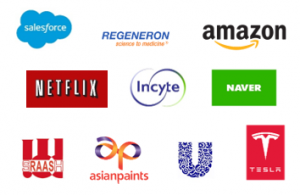 Salesforce.com
Salesforce.com- Tesla
- Amazon.com
- Shanghai RAAS Blood Products
- Netflix
- Incyte
- Hindustan Unilever
- Asian Paints
- Naver
- Regeneron Pharmaceuticals
While some of these companies are household names and others are popular on the other side of the globe, they all have a few key elements in common. First and foremost, they have been able to provide products and services that have disrupted traditional markets. They have looked for ways to improve the customer experience and to leverage emerging technology to provide innovation solutions to age-old problems, soothe pain points and fulfill needs. In addition, a lot of their success be attributed to the fact that they use open source software and welcome collaboration from a wide variety of sources. These leading innovators don’t shy away from collaborating with external resources in order to identify new markets and move their company forward.
Exploring Top Innovation Management Platforms
Just as the world’s most innovative companies are fueled by process and collaboration, the software powering modern innovation increasingly reflects this dynamic spirit. Let’s take a closer look at some of the most popular innovation management platforms, examining what sets them apart—and where they might fall short.
Key Features to Look For
Most leading solutions share several foundational capabilities:
- Customizable Workflows: Tailor the platform to fit unique processes, from initial brainstorming to final product launch.
- Idea Submission Portals: Create clear pathways for gathering ideas, whether from employees, partners, or even customers.
- Powerful Visualization Tools: Interactive dashboards, roadmaps, and matrices make it easier to evaluate opportunities and track progress.
- Collaboration & Crowdsourcing: Built-in features for crowdsourcing ideas and encouraging open dialogue, breaking down internal silos.
- Integration with Popular Tools: Seamless connections with platforms like Slack, Microsoft Teams, or other organizational favorites.
- AI-Assisted Evaluation: Automated trend analysis and idea scoring to turn insights into action more quickly.
The Upsides
- Flexibility: Leading platforms offer a modular, highly customizable experience—so businesses can align software with their unique vocabulary and workflow.
- End-to-End Management: From spotting the next big trend to prioritizing what hits the market, everything can be managed in a single, centralized system.
- Global Engagement: By bringing together voices from around the company (or beyond), these platforms can unlock creativity that might otherwise go unheard.
- Data-Driven Decision Making: Modern visualization and analytics tools add clarity, helping teams make smarter choices faster.
Potential Downsides
- Complexity for Small Teams: With so many features and customization options, some platforms can feel overwhelming—especially for businesses just starting their innovation journey or operating with limited resources.
- Learning Curve: Getting the most out of these robust systems may require extra time, training, and sometimes even external consulting.
- Integration Challenges: Not every tool connects perfectly with existing systems—so it pays to double-check compatibility before diving in.
By evaluating these features, strengths, and limitations, businesses can better determine which innovation management platform will truly empower their teams.
What Are Some of the Top Innovation Management Software Platforms for 2025?
Staying ahead in today’s rapidly evolving marketplace means having the right tools to capture, manage, and develop breakthrough ideas. Fortunately, there’s no shortage of platforms that empower teams to push boundaries and streamline the innovation process. For 2025, several solutions stand out for their ability to nurture creativity, facilitate collaboration, and drive measurable results.
Here are just a few leading innovation management software platforms making waves:
- Brightidea : Renowned for its user-friendly interface, Brightidea makes it easy to launch idea campaigns, gather insights from employees worldwide, and track ideas from concept to implementation. With built-in integrations for popular workplace tools and robust campaign management features, Brightidea fosters a strong culture of engagement across distributed teams.
- Qmarkets : A flexible solution ideal for organizations of all sizes, Qmarkets allows you to set up tailored workflows for everything from idea crowdsourcing and hackathons to project portfolio management. Its powerful analytics features help you evaluate, prioritize, and advance the ideas with the most potential.
- Spigit : Specializing in large-scale idea generation, Spigit streamlines the evaluation and selection process with automated scoring and crowd-voting. The platform’s collaborative features encourage widespread participation, breaking down silos and harnessing collective intelligence.
- Planbox : This platform offers end-to-end innovation management, from idea capture to project execution. Its robust reporting and dashboard tools give teams the visibility they need to track progress and deliver impactful results—all while staying aligned with strategic goals.
- HYPE Innovation : With strong support for both open innovation and internal collaboration, HYPE Innovation provides configurable portals for idea submission and development. Its focus on transparency and measurable outcomes supports organizations in building a sustainable pipeline of valuable solutions.
No matter the size of your organization or the scope of your ambitions, these platforms provide essential structure, automation, and visibility—helping ensure promising ideas transform into market-ready innovations.
Advantages and Challenges of Using Innosabi for Innovation Management
Choosing the right innovation management platform can be a make-or-break decision for enterprise teams looking to drive transformation. Innosabi , for example, offers a robust suite of features designed with large organizations in mind, aimed at making the flow of ideas smoother and more collaborative. But like any tool, it comes with its own pros and cons worth considering.
Advantages of Innosabi
- Comprehensive Stakeholder Involvement: Innosabi enables companies to launch targeted campaigns that draw on insights from employees, customers, suppliers, and partners. This approach opens the floor to a broader range of voices and helps surface creative solutions to company-specific challenges.
- Employee Engagement: Its approach to digital idea management is structured to encourage participation, recognize valuable suggestions, and create a culture where every voice can contribute to improvement.
- End-to-End Innovation Support: The platform supports the entire innovation journey, from idea collection through to project implementation. Its campaign management tools stand out for facilitating crowdsourcing and building employee engagement around key initiatives.
Challenges to Keep in Mind
- Potential Redundancy with Existing Tools: For enterprises already invested in robust ecosystems like Microsoft 365 or Google Workspace , some features—such as document management or communications—may overlap rather than complement what’s already in place. This can result in function duplication and underutilization.
- Learning Curve and Complexity: While basic tasks are straightforward, designing and configuring campaigns within Innosabi can be daunting at first. The array of available settings may be confusing for new users, and tapping into advanced functionalities often requires extra learning and training.
- Integration Limitations: Seamlessly linking Innosabi with other internal systems isn’t always guaranteed. Gaps in integration can interrupt workflow continuity and create frustration for teams used to tightly connected toolchains.
Ultimately, the key to leveraging Innosabi ’s strengths lies in carefully evaluating how well it fits with your organization’s existing processes and tech landscape. As with any innovation platform, success comes not just from the software itself, but from the clarity of vision and commitment to culture that organizations bring to the table.
Strengths and Weaknesses of HYPE Innovation
When evaluating HYPE Innovation as an idea management platform, several strengths stand out. Many users highlight the company’s proactive and accessible customer support team, who are quick to guide users through any platform hurdles—an asset that can make a real difference, especially during early adoption or transition periods. On the technology front, HYPE’s ability to integrate with diverse, dedicated data sources not only enriches the overall analytics experience but also empowers teams to make smarter, insight-driven decisions across departments.
However, it’s important to be aware of some areas where users report room for improvement. The platform’s configuration options have been described as somewhat inflexible, presenting challenges when organizations have highly specific customization needs. Finding your way around the backend can also be tricky, with some users struggling with navigation or tracking down lesser-used features. Another consideration for larger businesses: the licensing structure may limit the platform’s scalability by restricting the number of users, which could slow organization-wide adoption. Last but not least, while collaboration and ideation are strong points, project management tools within the platform have received mixed reviews. Enhancing this area—perhaps with more advanced workflow tools—could provide a more seamless experience from idea capture to implementation.
Why Innovation Software? Accelerate Time-to-Innovate
Innovation software represents a truly flexible tool that can be customized to fit the needs of any business. Being able to capture ideas, through a variety of methods, allows businesses to work with both internal and external collaborators. Automated idea management tools provide a quick and easy way to sort through massive amounts of information and prevent valuable ideas from slipping through the cracks. From there, ideas can be prioritized and developed on a more efficient schedule that put products on the market faster to stay ahead of the competition. In increasingly global markets, innovation software provides enterprise businesses with the power to tap into a wide range of experts and resources to drive innovation.
In many organizations, fragmentation of efforts and siloed thinking can be a significant barrier to true innovation. Departments often work in isolation, resulting in duplicated ideas and missed opportunities because valuable insights are not shared across teams. This lack of collaboration hampers the development of holistic, impactful solutions and slows down the pace at which companies can respond to new challenges.
Moreover, by consolidating new products, innovative ideas, and market insights in a centralized location, organizations can eliminate information silos that often lead to duplicated efforts and missed opportunities. Centralization not only creates transparency but also ensures that everyone stays on the same page, reducing inefficiencies and fostering a culture of openness. This unified approach helps teams collaborate more effectively, keeping the focus on turning great ideas into reality.
Pros and Cons of Qmarkets for Innovation Management
When considering a solution to facilitate streamlined innovation processes, Qmarkets offers a blend of advantages and challenges for organizations aiming to drive collaborative growth.
Pros:
- Responsive Support: One standout feature is the dedicated customer success team that jumps in to address platform concerns, ensuring that organizations receive timely, informed guidance to keep innovation programs running smoothly.
- Smart Idea Comparison: The platform provides an automated mechanism to cross-check new submissions against existing ones, conveniently surfacing related ideas. This not only aids evaluators in quickly identifying overlap but also reduces redundant suggestions, encouraging higher-quality input.
Cons:
- User Interface Hurdles: Some users report that the navigation and overall platform structure aren’t as intuitive as hoped, occasionally leading to bottlenecks when executing tasks or managing submissions.
- Customization Limitations: Organizations looking to closely tailor automated newsletters or campaign forms to align with their internal branding or communication style may encounter constraints—not all components are easily customizable to specific preferences.
- Reporting Gaps: For teams that prioritize robust measurement, the current analytics and reporting tools might feel a bit limited, making it harder to gain deep insights or track the granular progression of innovation initiatives.
- Idea History Tracking: Following the evolution of an idea—especially with multiple evaluators involved—can sometimes become confusing, complicating efforts to monitor feedback or decision points over time.
By weighing these pros and cons, organizations can better determine whether Qmarkets aligns with their innovation strategy and team workflow.






